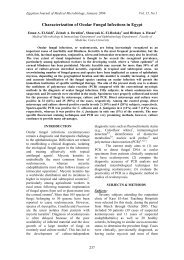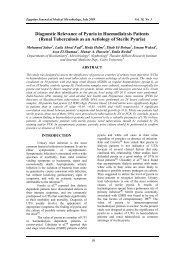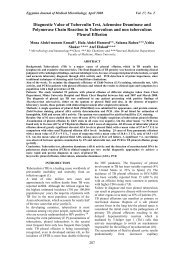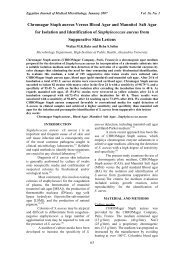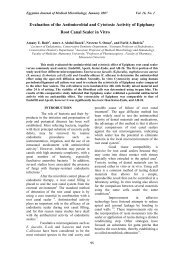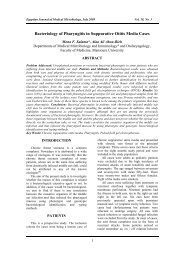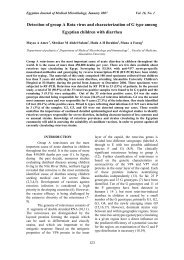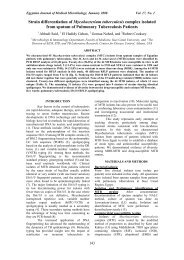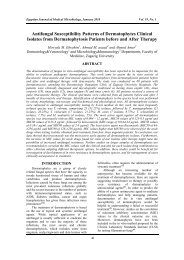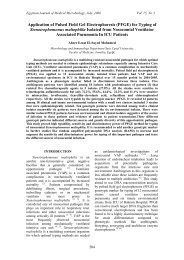Influence of Aqueous Green Tea Extract on the Antimicrobial Activity ...
Influence of Aqueous Green Tea Extract on the Antimicrobial Activity ...
Influence of Aqueous Green Tea Extract on the Antimicrobial Activity ...
Create successful ePaper yourself
Turn your PDF publications into a flip-book with our unique Google optimized e-Paper software.
Egyptian Journal <str<strong>on</strong>g>of</str<strong>on</strong>g> Medical Microbiology, July 2008 Vol. 17, No. 3<br />
<str<strong>on</strong>g>Influence</str<strong>on</strong>g> <str<strong>on</strong>g>of</str<strong>on</strong>g> <str<strong>on</strong>g>Aqueous</str<strong>on</strong>g> <str<strong>on</strong>g>Green</str<strong>on</strong>g> <str<strong>on</strong>g>Tea</str<strong>on</strong>g> <str<strong>on</strong>g>Extract</str<strong>on</strong>g> <strong>on</strong> <strong>the</strong> <strong>Antimicrobial</strong> <strong>Activity</strong><br />
<str<strong>on</strong>g>of</str<strong>on</strong>g> some Antibiotics against Multiresistant Clinical Isolates<br />
Nourhan H. Fanaki, Mervat A. Kassem*, Mohamed A. Fawzi and Fatma S.E. Dabbous<br />
Department <str<strong>on</strong>g>of</str<strong>on</strong>g> Pharmaceutical Microbiology, Faculty <str<strong>on</strong>g>of</str<strong>on</strong>g> Pharmacy, Alexandria University,<br />
ABSTRACT<br />
<str<strong>on</strong>g>Green</str<strong>on</strong>g> tea has been shown to have several antibacterial activities, limiting bacterial growth and acting in<br />
synergy with β-lactam antibiotics. Antibiotics bel<strong>on</strong>ging to different groups were tested separately and in<br />
combinati<strong>on</strong>s with green tea against different isolates using disc agar diffusi<strong>on</strong> technique. The bactericidal<br />
activity <str<strong>on</strong>g>of</str<strong>on</strong>g> certain antibiotics against selected isolates was evaluated separately and in presence <str<strong>on</strong>g>of</str<strong>on</strong>g> green tea<br />
using surface viable count. Subinhibitory c<strong>on</strong>centrati<strong>on</strong>s <str<strong>on</strong>g>of</str<strong>on</strong>g> green tea showed marked increase in <strong>the</strong><br />
sensitivity <str<strong>on</strong>g>of</str<strong>on</strong>g> even <strong>the</strong> multiple resistant isolates to most <str<strong>on</strong>g>of</str<strong>on</strong>g> <strong>the</strong> antibiotics tested. Moreover, <str<strong>on</strong>g>Green</str<strong>on</strong>g> tea<br />
enhanced <strong>the</strong> bactericidal activity <str<strong>on</strong>g>of</str<strong>on</strong>g> all tested antibiotics. <str<strong>on</strong>g>Green</str<strong>on</strong>g> tea had <strong>the</strong> ability to cure resistance to<br />
cefuroxime. In additi<strong>on</strong>, <strong>the</strong> effect <str<strong>on</strong>g>of</str<strong>on</strong>g> green tea <strong>on</strong> direct inhibiti<strong>on</strong> <str<strong>on</strong>g>of</str<strong>on</strong>g> β-lactamases producti<strong>on</strong> was c<strong>on</strong>ducted<br />
using <strong>the</strong> nitrocefin method. There were beneficial outcomes <str<strong>on</strong>g>of</str<strong>on</strong>g> c<strong>on</strong>comitant administrati<strong>on</strong> <str<strong>on</strong>g>of</str<strong>on</strong>g> green tea with<br />
tetracycline, chloramphenicol as well as β-lactam antibiotics.<br />
INTRODUCTION<br />
<str<strong>on</strong>g>Tea</str<strong>on</strong>g> beverage is an infusi<strong>on</strong> <str<strong>on</strong>g>of</str<strong>on</strong>g> variously processed<br />
leaves <str<strong>on</strong>g>of</str<strong>on</strong>g> <strong>on</strong>e <str<strong>on</strong>g>of</str<strong>on</strong>g> <strong>the</strong> varieties <str<strong>on</strong>g>of</str<strong>on</strong>g> an evergreen<br />
shrub, Camellia sinensis family Theaceae (1) . It is<br />
c<strong>on</strong>sumed every day by billi<strong>on</strong>s <str<strong>on</strong>g>of</str<strong>on</strong>g> people<br />
worldwide dem<strong>on</strong>strating its safety<br />
(2) . <str<strong>on</strong>g>Tea</str<strong>on</strong>g><br />
beverage, next to water, is <strong>the</strong> most popularly<br />
c<strong>on</strong>sumed beverage in <strong>the</strong> world due to its ability<br />
to revive, refresh and relax <strong>the</strong> body and mind (3, 4) .<br />
<str<strong>on</strong>g>Tea</str<strong>on</strong>g> is generally c<strong>on</strong>sumed in <strong>the</strong> form <str<strong>on</strong>g>of</str<strong>on</strong>g> black,<br />
ool<strong>on</strong>g or green tea. <str<strong>on</strong>g>Green</str<strong>on</strong>g> tea differs from black<br />
tea in that an oxidati<strong>on</strong> step, called "fermentati<strong>on</strong>",<br />
occurs in <strong>the</strong> processing <str<strong>on</strong>g>of</str<strong>on</strong>g> <strong>the</strong> latter. <str<strong>on</strong>g>Tea</str<strong>on</strong>g> c<strong>on</strong>sists<br />
mainly <str<strong>on</strong>g>of</str<strong>on</strong>g> polyphenolic compounds, about 60 –<br />
80%, that make up ~ 30 % <str<strong>on</strong>g>of</str<strong>on</strong>g> <strong>the</strong> dry weight <str<strong>on</strong>g>of</str<strong>on</strong>g><br />
flush (1) . Epigallocatechin gallate (EGCG) is <strong>the</strong><br />
most abundant catechin in most green tea<br />
brands (4) .<br />
<str<strong>on</strong>g>Green</str<strong>on</strong>g> tea has been shown to have a wide range <str<strong>on</strong>g>of</str<strong>on</strong>g><br />
beneficial physiological and pharmacological<br />
effects. In additi<strong>on</strong>, <strong>the</strong> antimicrobial activity <str<strong>on</strong>g>of</str<strong>on</strong>g><br />
green tea, recognized about 90 years ago, is<br />
mainly due to EGCG, <strong>the</strong> main comp<strong>on</strong>ent <str<strong>on</strong>g>of</str<strong>on</strong>g> tea<br />
polyphenols (3, 5-7) . It was found that green tea<br />
extracts exhibited bacteriostatic and bactericidal<br />
activities against both methicillin-resistant<br />
Staphylococcus aureus (MRSA) and methicillinsensitive<br />
S. aureus (MSSA) (8) , S. epidermidis,<br />
Salm<strong>on</strong>ella typhi, Sa. typhimurium, Sa. enteritidis,<br />
Shigella flexneri, Sh. dysenteriae, Bordetella<br />
pertussis (9) and Vibrio spp, including V. cholerae<br />
(7) . Synergistic bactericidal effects between β-<br />
lactams as ampicillin/sulbactam or imipenem and<br />
EGCG against MRSA isolates were reported (10, 11) .<br />
In additi<strong>on</strong>, it was reported that EGCG could<br />
reverse <strong>the</strong> methicillin resistance <str<strong>on</strong>g>of</str<strong>on</strong>g> MRSA by<br />
inhibiting <strong>the</strong> syn<strong>the</strong>sis <str<strong>on</strong>g>of</str<strong>on</strong>g> PBP2' (5) . Moreover,<br />
EGCG did not enhance <strong>on</strong>ly β-lactams activity but<br />
also it enhanced <strong>the</strong> activity <str<strong>on</strong>g>of</str<strong>on</strong>g> n<strong>on</strong>-β-lactam cell<br />
wall biosyn<strong>the</strong>sis inhibitiors such as D-cycloserine<br />
(12) .<br />
The possibility to drink green tea with antibiotics<br />
could be so easily to happen. The effect <str<strong>on</strong>g>of</str<strong>on</strong>g> GT <strong>on</strong><br />
<strong>the</strong> antimicrobial activity <str<strong>on</strong>g>of</str<strong>on</strong>g> some antibiotics has<br />
been reported in a limited number <str<strong>on</strong>g>of</str<strong>on</strong>g> studies (1) .<br />
C<strong>on</strong>sequently, <strong>the</strong> main aim <str<strong>on</strong>g>of</str<strong>on</strong>g> our investigati<strong>on</strong><br />
was to evaluate <strong>the</strong> antimicrobial activity <str<strong>on</strong>g>of</str<strong>on</strong>g> <strong>the</strong><br />
combinati<strong>on</strong>s <str<strong>on</strong>g>of</str<strong>on</strong>g> green tea and some selected<br />
antibiotics against multiresistant clinical isolates.<br />
MATERIALS and METHODS<br />
Microorganisms: The standards strains used in<br />
this study were: Staphlycoccus aureus ATCC<br />
6538P, Escherichia coli NCTC 10418 and<br />
Pseudom<strong>on</strong>as aeruginosa ATCC 9027.<br />
The twenty eight bacterial isolates used in this<br />
study were collected from different sources (urine<br />
10, pus 9, blood 4, sputum 2, stool 2, and used<br />
c<strong>on</strong>tact lens 1). They were as follows: S. aureus<br />
(14), S. epidermidis (2), S. saprophyticus (1), E.<br />
coli (8), Ps. aeruginosa (2) and Enterobacter<br />
sakazakii (1).<br />
Culture media: The following Oxoid-made<br />
media were used: Nutrient broth No. 2 (NB),<br />
Nutrient agar, and a chemically defined medium<br />
(CDM) pH adjusted to 6.8 ±0.1 (13) .<br />
<str<strong>on</strong>g>Green</str<strong>on</strong>g> <str<strong>on</strong>g>Tea</str<strong>on</strong>g>: Dried leaves <str<strong>on</strong>g>of</str<strong>on</strong>g> Camellia sinensis<br />
(R.Twingins, L<strong>on</strong>d<strong>on</strong>, England).<br />
Antibiotic Sensitivity Discs: All antibiotic discs<br />
were <strong>the</strong> product <str<strong>on</strong>g>of</str<strong>on</strong>g> BIOANALYSE Tibbi<br />
Malzemeler San. Ve Tic. Ltd. Sti Turkey.).<br />
Antibiotics:The antimicrobial agents used in this<br />
study were obtained from <strong>the</strong> corresp<strong>on</strong>ding<br />
pharmaceutical companies: Cefoperaz<strong>on</strong>e sodium<br />
(Pharco Pharmaceutical Co., Egypt), Cefuroxime<br />
sodium (Galaxo Wellcome, Egypt),<br />
Chloramphenicol (Alexandria Co., Egypt),<br />
Cipr<str<strong>on</strong>g>of</str<strong>on</strong>g>loxacin (Sreepathi Pharmaceutical Ltd,<br />
449
Egyptian Journal <str<strong>on</strong>g>of</str<strong>on</strong>g> Medical Microbiology, July 2008 Vol. 17, No. 3<br />
India), Erythromycin (Alexandria Co, Egypt),<br />
Penicillin G (MISR Co. for Pharm. Ind S.A.E.,<br />
Egypt) and Tetracycline HCl (Chemical Industries<br />
Development, Egypt).<br />
Preparati<strong>on</strong> <str<strong>on</strong>g>of</str<strong>on</strong>g> sterilized green tea extract<br />
(GT): Ten grams <str<strong>on</strong>g>of</str<strong>on</strong>g> ungrounded leaves <str<strong>on</strong>g>of</str<strong>on</strong>g> green<br />
tea was soaked in 100 ml boiling distilled water<br />
for 10 min. The extract was filtered from <strong>the</strong><br />
leaves by mean <str<strong>on</strong>g>of</str<strong>on</strong>g> gauze (14) . The filtrate was <strong>the</strong>n<br />
centrifuged using ML W T 51, GDR centrifuge at<br />
<strong>the</strong> highest speed (III) for 5 min. The supernatant<br />
was <strong>the</strong>n collected and sterilized by filtrati<strong>on</strong><br />
through a membrane filter <str<strong>on</strong>g>of</str<strong>on</strong>g> a 0.45 µm pore size.<br />
Only freshly prepared sterilized green tea extract<br />
(GT) was used (15) .<br />
1. Effect <str<strong>on</strong>g>of</str<strong>on</strong>g> different GT <strong>on</strong> <strong>the</strong> antimicrobial<br />
activity <str<strong>on</strong>g>of</str<strong>on</strong>g> different antibiotics using disc agar<br />
diffusi<strong>on</strong> technique:<br />
It was adopted by Ghobashy A.A. (16) with some<br />
modificati<strong>on</strong>s as follows:<br />
Preparati<strong>on</strong> <str<strong>on</strong>g>of</str<strong>on</strong>g> <strong>the</strong> agar plates: Sterile nutrient<br />
agar plates were prepared to c<strong>on</strong>tain final<br />
c<strong>on</strong>centrati<strong>on</strong> equivalent to 1/4 MIC <str<strong>on</strong>g>of</str<strong>on</strong>g> GT when<br />
used to test Gram positive bacteria or 10 mg/ml in<br />
case <str<strong>on</strong>g>of</str<strong>on</strong>g> Gram negative bacteria, in additi<strong>on</strong> to <strong>the</strong><br />
c<strong>on</strong>trol plates (free <str<strong>on</strong>g>of</str<strong>on</strong>g> GT).<br />
Preparati<strong>on</strong> <str<strong>on</strong>g>of</str<strong>on</strong>g> inoculum: Each tested organism<br />
was subcultured in 3 ml sterile nutrient broth and<br />
<strong>the</strong> resultant microbial growth was firstly<br />
compared with 0.5 'McFarland Opacity Standard'<br />
which was equivalent to approximately 10 8 cfu/ml<br />
and properly diluted, if necessary, to achieve <strong>the</strong><br />
same turbidity <str<strong>on</strong>g>of</str<strong>on</strong>g> <strong>the</strong> standard.<br />
Procedure <str<strong>on</strong>g>of</str<strong>on</strong>g> <strong>the</strong> test: The inoculum was spread<br />
<strong>on</strong>to <strong>the</strong> surface <str<strong>on</strong>g>of</str<strong>on</strong>g> <strong>the</strong> nutrient plates by means <str<strong>on</strong>g>of</str<strong>on</strong>g><br />
sterile cott<strong>on</strong> swabs. The plates were <strong>the</strong>n left to<br />
dry aseptically at room temperature for few min.<br />
C<strong>on</strong>trol plate: was prepared by inoculating <strong>the</strong><br />
nutrient agar plate with swab <str<strong>on</strong>g>of</str<strong>on</strong>g> tested<br />
microorganism.<br />
Combinati<strong>on</strong> plate: was prepared by inoculating<br />
<strong>the</strong> nutrient agar plate c<strong>on</strong>taining <strong>the</strong><br />
corresp<strong>on</strong>ding c<strong>on</strong>centrati<strong>on</strong> <str<strong>on</strong>g>of</str<strong>on</strong>g> <strong>the</strong> GT using swab<br />
<str<strong>on</strong>g>of</str<strong>on</strong>g> tested microorganism.<br />
The antibiotic discs were <strong>the</strong>n distributed <strong>on</strong>to <strong>the</strong><br />
surface <str<strong>on</strong>g>of</str<strong>on</strong>g> each inoculated plate. The space<br />
between <strong>the</strong> discs must not be narrower than 24<br />
mm and <strong>the</strong> distance <str<strong>on</strong>g>of</str<strong>on</strong>g> <strong>the</strong> discs from <strong>the</strong> edge <str<strong>on</strong>g>of</str<strong>on</strong>g><br />
<strong>the</strong> plate must be not less than 10 mm. The plates<br />
were <strong>the</strong>n incubated at 37ºC for 18 h and <strong>the</strong><br />
average diameter <str<strong>on</strong>g>of</str<strong>on</strong>g> inhibiti<strong>on</strong> z<strong>on</strong>es around <strong>the</strong><br />
discs was determined and compared to <strong>the</strong><br />
corresp<strong>on</strong>ding c<strong>on</strong>trol plate. The results were <strong>the</strong>n<br />
translated into susceptible (S), intermediate (I) or<br />
resistant (R) according to <strong>the</strong> published Tables <str<strong>on</strong>g>of</str<strong>on</strong>g><br />
<strong>the</strong> Nati<strong>on</strong>al Committee <str<strong>on</strong>g>of</str<strong>on</strong>g> Clinical Laboratory<br />
Standards NCCLS 2002 (17) .<br />
To insure <strong>the</strong> reproducibility <str<strong>on</strong>g>of</str<strong>on</strong>g> <strong>the</strong> results each<br />
experiment was repeated 3 times throughout this<br />
study.<br />
2. Investigati<strong>on</strong> <str<strong>on</strong>g>of</str<strong>on</strong>g> dynamics <str<strong>on</strong>g>of</str<strong>on</strong>g> <strong>the</strong><br />
antimicrobial activity <str<strong>on</strong>g>of</str<strong>on</strong>g> GT-antibiotic<br />
combinati<strong>on</strong>s against selected bacterial isolates:<br />
For each case, 4 flasks were prepared each with a<br />
final volume <str<strong>on</strong>g>of</str<strong>on</strong>g> 9 ml, flask <strong>on</strong>e c<strong>on</strong>tained <strong>the</strong><br />
appropriate antibiotic c<strong>on</strong>centrati<strong>on</strong> in sterile<br />
chemically defined media (CDM). The sec<strong>on</strong>d<br />
c<strong>on</strong>tained <strong>the</strong> required c<strong>on</strong>centrati<strong>on</strong> <str<strong>on</strong>g>of</str<strong>on</strong>g> GT in<br />
CDM. The third c<strong>on</strong>tained a combinati<strong>on</strong> <str<strong>on</strong>g>of</str<strong>on</strong>g> <strong>the</strong><br />
antibiotic and <strong>the</strong> GT in <strong>the</strong> same medium while<br />
<strong>the</strong> forth flask had 9 ml CDM and was c<strong>on</strong>sidered<br />
as c<strong>on</strong>trol.<br />
At zero time, all flasks were inoculated each with<br />
1 ml <str<strong>on</strong>g>of</str<strong>on</strong>g> <strong>the</strong> tested bacterial suspensi<strong>on</strong> c<strong>on</strong>taining<br />
about 10 8 cfu/ml. The flasks were mixed well and<br />
placed in shaking water bath (25 strokes/min) at<br />
37ºC. Samples were withdrawn from each flask at<br />
0, 1, 2, 4 and 6 h and <strong>the</strong> samples were <strong>the</strong>n ten<br />
fold serially diluted with sterile saline. 40 µl<br />
samples <str<strong>on</strong>g>of</str<strong>on</strong>g> <strong>the</strong> different diluti<strong>on</strong>s were dropped<br />
separately <strong>on</strong>to <strong>the</strong> surface <str<strong>on</strong>g>of</str<strong>on</strong>g> overdried nutrient<br />
agar plates. The plates were <strong>the</strong>n incubated at<br />
37ºC for 24 h. The number <str<strong>on</strong>g>of</str<strong>on</strong>g> col<strong>on</strong>ies was<br />
determined and <strong>the</strong> average number <str<strong>on</strong>g>of</str<strong>on</strong>g> survivors<br />
was <strong>the</strong>n calculated (18) .<br />
3. Effect <str<strong>on</strong>g>of</str<strong>on</strong>g> GT <strong>on</strong> <strong>the</strong> modulati<strong>on</strong> <str<strong>on</strong>g>of</str<strong>on</strong>g> antibiotic<br />
resistance in certain bacterial isolates:<br />
3.1. Curing <str<strong>on</strong>g>of</str<strong>on</strong>g> some antibiotic-resistance<br />
bacterial isolates with GT:<br />
Bacterial suspensi<strong>on</strong>s were prepared <str<strong>on</strong>g>of</str<strong>on</strong>g> <strong>the</strong><br />
corresp<strong>on</strong>ding overnight cultures to c<strong>on</strong>tain about<br />
10 4 cfu/ml for each isolate. Aliquots <str<strong>on</strong>g>of</str<strong>on</strong>g> 100 µl <str<strong>on</strong>g>of</str<strong>on</strong>g><br />
each suspensi<strong>on</strong> were <strong>the</strong>n spread separately over<br />
<strong>the</strong> surface <str<strong>on</strong>g>of</str<strong>on</strong>g> overdried nutrient agar plates which<br />
were <strong>the</strong>n incubated at 37°C for 24 h.<br />
Copies <str<strong>on</strong>g>of</str<strong>on</strong>g> <strong>the</strong> c<strong>on</strong>trol plates with separate col<strong>on</strong>ies<br />
<str<strong>on</strong>g>of</str<strong>on</strong>g> untreated Staphylococcus and Gram negative<br />
isolates were transferred to nutrient agar plates<br />
c<strong>on</strong>taining 1 mg/ml and 10 mg/ml, respectively<br />
using sterile tooth picks and incubated overnight<br />
at 37°C. These plates were c<strong>on</strong>sidered as cured<br />
plates. C<strong>on</strong>trol plates lacking GT were prepared<br />
for each isolate al<strong>on</strong>g with <strong>the</strong> cured plates.<br />
Two sets <str<strong>on</strong>g>of</str<strong>on</strong>g> nutrient agar plates c<strong>on</strong>taining two<br />
fold serial diluti<strong>on</strong>s <str<strong>on</strong>g>of</str<strong>on</strong>g> selected antibiotics<br />
(cefoperaz<strong>on</strong>e, cefuroxime, chloramphenicol or<br />
tetracycline HCl) were freshly prepared. The<br />
highest c<strong>on</strong>centrati<strong>on</strong> used was always 2 fold<br />
higher than <strong>the</strong> antibiotic resistance breakpoint<br />
against <strong>the</strong> tested microorganism.<br />
Each developed col<strong>on</strong>y in <strong>the</strong> cured plates as well<br />
as its corresp<strong>on</strong>ding col<strong>on</strong>y in c<strong>on</strong>trol plates was<br />
transferred individually <strong>on</strong> <strong>the</strong> surface <str<strong>on</strong>g>of</str<strong>on</strong>g> nutrient<br />
agar plates c<strong>on</strong>taining serial diluti<strong>on</strong>s <str<strong>on</strong>g>of</str<strong>on</strong>g> <strong>the</strong><br />
selected antibiotic using <strong>the</strong> same tooth pick. The<br />
plates were incubated at 37°C for 24 h. The<br />
450
Egyptian Journal <str<strong>on</strong>g>of</str<strong>on</strong>g> Medical Microbiology, July 2008 Vol. 17, No. 3<br />
values <str<strong>on</strong>g>of</str<strong>on</strong>g> MIC <str<strong>on</strong>g>of</str<strong>on</strong>g> each antibiotic to each col<strong>on</strong>y<br />
were recorded for both untreated and treated<br />
isolates (19) .<br />
3.2. Direct inhibitory effect <str<strong>on</strong>g>of</str<strong>on</strong>g> GT <strong>on</strong> isolated β-<br />
lactamases <str<strong>on</strong>g>of</str<strong>on</strong>g> S. aureus isolate using nitrocefin<br />
method:<br />
Preparati<strong>on</strong> <str<strong>on</strong>g>of</str<strong>on</strong>g> cell suspensi<strong>on</strong>: S. aureus isolate,<br />
S 9 was subcultured <strong>on</strong> nutrient agar slant and <strong>the</strong><br />
resultant growth was washed up aseptically by 2<br />
ml phosphate buffer (pH 7). The c<strong>on</strong>tent <str<strong>on</strong>g>of</str<strong>on</strong>g><br />
microbial culture was vortexed and transferred<br />
aseptically to a sterile empty test tube.<br />
Producti<strong>on</strong> <str<strong>on</strong>g>of</str<strong>on</strong>g> β-lactamases: The microbial<br />
suspensi<strong>on</strong> was mixed with equal volume <str<strong>on</strong>g>of</str<strong>on</strong>g><br />
penicillin G soluti<strong>on</strong> (12 mg/mldissolved in sterile<br />
phosphate buffer pH 7). The mixture was <strong>the</strong>n<br />
incubated at 37°C for 1 h (20) . After incubati<strong>on</strong>,<br />
<strong>the</strong> suspensi<strong>on</strong> was centrifuged for 15 min. The<br />
supernatant was c<strong>on</strong>sidered as stock soluti<strong>on</strong> <str<strong>on</strong>g>of</str<strong>on</strong>g> β-<br />
lactamases.<br />
Procedure <str<strong>on</strong>g>of</str<strong>on</strong>g> test: The stock β-lactamases<br />
soluti<strong>on</strong> was distributed in 0.5 ml porti<strong>on</strong>s in 3<br />
empty sterile test tubes. The first tube was<br />
preincubated for 30 min with 1 mg/ml<str<strong>on</strong>g>of</str<strong>on</strong>g> GT, <strong>the</strong><br />
sec<strong>on</strong>d with 1/2 mg/ ml <str<strong>on</strong>g>of</str<strong>on</strong>g> GT while <strong>the</strong> third<br />
received sterile distilled water and was c<strong>on</strong>sidered<br />
as c<strong>on</strong>trol. Nitrocefin soluti<strong>on</strong> (500 µg/ml) was<br />
<strong>the</strong>n added as a substrate to each test tube. The<br />
resultant color change was recorded by detecting<br />
<strong>the</strong> absorbance at 492 nm after 30 min with<br />
spectrophotometer (Spekol II, Carl Zeiss, Jena,<br />
Germany) (21) . The percentage <str<strong>on</strong>g>of</str<strong>on</strong>g> inhibiti<strong>on</strong> <str<strong>on</strong>g>of</str<strong>on</strong>g><br />
enzyme activity was determined graphically<br />
according to <strong>the</strong> calibrati<strong>on</strong> curve <str<strong>on</strong>g>of</str<strong>on</strong>g> β-lactamases<br />
which was discussed in <strong>the</strong> next secti<strong>on</strong> (22) .<br />
Moreover, <strong>the</strong> absorbance <str<strong>on</strong>g>of</str<strong>on</strong>g> mixture <str<strong>on</strong>g>of</str<strong>on</strong>g> 1 mg/ml<br />
GT and nitrocefin soluti<strong>on</strong> (500 µg/ml) was<br />
measured to insure <strong>the</strong> absence <str<strong>on</strong>g>of</str<strong>on</strong>g> any<br />
interference.<br />
C<strong>on</strong>structi<strong>on</strong> <str<strong>on</strong>g>of</str<strong>on</strong>g> standard curve <str<strong>on</strong>g>of</str<strong>on</strong>g> β-<br />
lactamases: Stock β-lactamases was 2 fold<br />
serially diluted with phosphate buffer pH 7.<br />
Nitrocefin (500 µg/ml) was <strong>the</strong>n added and <strong>the</strong><br />
color change was measured as menti<strong>on</strong>ed earlier.<br />
The measured absorbance was plotted against log<br />
c<strong>on</strong>centrati<strong>on</strong> <str<strong>on</strong>g>of</str<strong>on</strong>g> β-lactamases and a regressi<strong>on</strong><br />
line was c<strong>on</strong>structed.<br />
3.3. Effect <str<strong>on</strong>g>of</str<strong>on</strong>g> subinhibitory c<strong>on</strong>centrati<strong>on</strong>s <str<strong>on</strong>g>of</str<strong>on</strong>g><br />
GT <strong>on</strong> <strong>the</strong> modulati<strong>on</strong> <str<strong>on</strong>g>of</str<strong>on</strong>g> tetracycline HCl<br />
susceptibility <str<strong>on</strong>g>of</str<strong>on</strong>g> some staphylococcus spp<br />
isolates:<br />
3.3.1. Effect <str<strong>on</strong>g>of</str<strong>on</strong>g> omeprazole, prot<strong>on</strong> pump<br />
inhibitor, and GT <strong>on</strong> <strong>the</strong> antimicrobial activity<br />
<str<strong>on</strong>g>of</str<strong>on</strong>g> tetracycline HCl using broth diluti<strong>on</strong><br />
technique:<br />
The MICs <str<strong>on</strong>g>of</str<strong>on</strong>g> tetracycline HCl against 10<br />
Staphylococcus spp isolates were determined in<br />
absence and presence <str<strong>on</strong>g>of</str<strong>on</strong>g> 100 µg/ml omeprazole as<br />
well as GT (0.75 mg/ml) using broth diluti<strong>on</strong><br />
method (23) .<br />
The 200 µg/ml tetracycline HCl stock soluti<strong>on</strong> was<br />
2 fold serially diluted in sterile distilled water and<br />
distributed in 0.5 ml porti<strong>on</strong>s in test tubes<br />
c<strong>on</strong>taining 0.5 ml <str<strong>on</strong>g>of</str<strong>on</strong>g> ei<strong>the</strong>r omeprazole soluti<strong>on</strong> or<br />
GT. Proper c<strong>on</strong>trol tubes were included in each<br />
set for each isolate.<br />
Aliquots <str<strong>on</strong>g>of</str<strong>on</strong>g> 1 ml double strength NB inoculated<br />
with <strong>the</strong> test organism (10 5 cfu/ml) were added to<br />
<strong>the</strong> test tubes giving final volume <str<strong>on</strong>g>of</str<strong>on</strong>g> 2 ml. The<br />
tubes were well shaken, <strong>the</strong>n incubated at 37°C for<br />
24 h. The MIC values were determined by <strong>the</strong><br />
visual inspecti<strong>on</strong> for turbidity.<br />
3.3.2. Direct inhibitory effect <str<strong>on</strong>g>of</str<strong>on</strong>g> GT <strong>on</strong> <strong>the</strong><br />
tetracycline HCl efflux pump <str<strong>on</strong>g>of</str<strong>on</strong>g> staphylococcus<br />
spp:<br />
Suspensi<strong>on</strong>s <str<strong>on</strong>g>of</str<strong>on</strong>g> 3 selected Staphylococcus isolates,<br />
S 4 , S 6 and S 16 each c<strong>on</strong>taining about 10 7 cfu/ml<br />
were preincubated at room temperature for 15 min<br />
in <strong>the</strong> absence and presence <str<strong>on</strong>g>of</str<strong>on</strong>g> 1 mg/ml. Each <str<strong>on</strong>g>of</str<strong>on</strong>g><br />
<strong>the</strong>m was <strong>the</strong>n loaded with 100 µg/ml tetracycline<br />
HCl for additi<strong>on</strong>al 15 min. The bacterial<br />
suspensi<strong>on</strong>s were <strong>the</strong>n centrifuged and <strong>the</strong><br />
resultant pellets were resuspended in 2 ml <str<strong>on</strong>g>of</str<strong>on</strong>g> Mg 2+<br />
buffer<br />
(24) . The released fluorescence was<br />
immediately recorded quantitatively using<br />
spectr<str<strong>on</strong>g>of</str<strong>on</strong>g>luorometer at 400 nm as excitati<strong>on</strong> wave<br />
length and 520 nm as emissi<strong>on</strong> wave length (25) .<br />
RESULTS and DISCUSSION<br />
1. Effect <str<strong>on</strong>g>of</str<strong>on</strong>g> GT <strong>on</strong> <strong>the</strong> antimicrobial activity <str<strong>on</strong>g>of</str<strong>on</strong>g><br />
different antibiotics against tested bacteria<br />
using disc agar diffusi<strong>on</strong> technique:<br />
<str<strong>on</strong>g>Tea</str<strong>on</strong>g> intake is sec<strong>on</strong>d to water in terms <str<strong>on</strong>g>of</str<strong>on</strong>g><br />
worldwide popularity as a beverage (4) . <str<strong>on</strong>g>Green</str<strong>on</strong>g> tea<br />
c<strong>on</strong>tains ~ 30 % polyphenolic compounds <str<strong>on</strong>g>of</str<strong>on</strong>g><br />
which 60-80% catechins (1, 3) . EGCG is <strong>the</strong> most<br />
abundant catechin in green tea (4) . In additi<strong>on</strong> to<br />
its antimicrobial activity, green tea has been<br />
shown to have a wide range <str<strong>on</strong>g>of</str<strong>on</strong>g> beneficial<br />
physiological and pharmacological effects (4) . As<br />
a popular habit in Egypt, it was noticed that <strong>the</strong>re<br />
is unintenti<strong>on</strong>al co-administrati<strong>on</strong> <str<strong>on</strong>g>of</str<strong>on</strong>g> antibiotics<br />
with a cup <str<strong>on</strong>g>of</str<strong>on</strong>g> tea that may occur frequently every<br />
day. It was also noticed that several researchers<br />
studied <strong>the</strong> combinati<strong>on</strong>s <str<strong>on</strong>g>of</str<strong>on</strong>g> green tea or its active<br />
comp<strong>on</strong>ents, EGCG and ECG, with some<br />
antimicrobial agents (10, 11) . Therefore, it was<br />
interesting to investigate <strong>the</strong> effect <str<strong>on</strong>g>of</str<strong>on</strong>g> green tea <strong>on</strong><br />
<strong>the</strong> antimicrobial activity <str<strong>on</strong>g>of</str<strong>on</strong>g> antibiotics <str<strong>on</strong>g>of</str<strong>on</strong>g> different<br />
groups against selected microorganisms.<br />
Antibiotics bel<strong>on</strong>ging to different groups with<br />
different mechanisms and targets <str<strong>on</strong>g>of</str<strong>on</strong>g> acti<strong>on</strong> were<br />
tested in this study. Their antimicrobial activity<br />
against Staphylococcus spp and Gram negative<br />
isolates and <strong>the</strong>ir available standard strains was<br />
tested in absence and presence <str<strong>on</strong>g>of</str<strong>on</strong>g> 1/4 MIC and 10<br />
451
Egyptian Journal <str<strong>on</strong>g>of</str<strong>on</strong>g> Medical Microbiology, July 2008 Vol. 17, No. 3<br />
mg/ml<str<strong>on</strong>g>of</str<strong>on</strong>g> GT, respectively, using <strong>the</strong> disc agar<br />
diffusi<strong>on</strong> technique. The selected c<strong>on</strong>centrati<strong>on</strong>s<br />
<str<strong>on</strong>g>of</str<strong>on</strong>g> GT were 1/4 MIC and 10 mg/mlsince <strong>the</strong> use <str<strong>on</strong>g>of</str<strong>on</strong>g><br />
1/2 MIC and 20 mg/mlresulted in too wide<br />
inhibiti<strong>on</strong> z<strong>on</strong>es surrounding <strong>the</strong> discs, which<br />
interfered with each o<strong>the</strong>rs.<br />
Twenty eight bacterial isolates, 17 Staphylococcus<br />
spp, 7 E. coli, <strong>on</strong>e Ent. sakazakii and 3 Ps.<br />
aeruginosa, in additi<strong>on</strong> to three standard strains<br />
(S T , E T and P T ) were involved in this experiment.<br />
A total <str<strong>on</strong>g>of</str<strong>on</strong>g> 16 and 13 <str<strong>on</strong>g>of</str<strong>on</strong>g> <strong>the</strong> comm<strong>on</strong>ly used<br />
antibiotics were employed in case <str<strong>on</strong>g>of</str<strong>on</strong>g><br />
Staphylococcus spp and Gram negative bacteria,<br />
respectively.<br />
The data in Tables 1 and 2 showed that <strong>the</strong><br />
presence <str<strong>on</strong>g>of</str<strong>on</strong>g> GT caused marked increase in <strong>the</strong><br />
sensitivity <str<strong>on</strong>g>of</str<strong>on</strong>g> multiple resistant Staphylococcus<br />
spp. as well as multiple resistant Gram negative<br />
isolates to most <str<strong>on</strong>g>of</str<strong>on</strong>g> <strong>the</strong> antibiotics tested.<br />
The sensitivity <str<strong>on</strong>g>of</str<strong>on</strong>g> 72% (13 out <str<strong>on</strong>g>of</str<strong>on</strong>g> 18) <str<strong>on</strong>g>of</str<strong>on</strong>g> tested<br />
Staphylococcus spp to different antibiotics was<br />
increased (up to 85%). The sensitivity <str<strong>on</strong>g>of</str<strong>on</strong>g> 50%<br />
percent <str<strong>on</strong>g>of</str<strong>on</strong>g> tested Staphylococcus spp resp<strong>on</strong>ded<br />
positively to <strong>the</strong> antimicrobial activity <str<strong>on</strong>g>of</str<strong>on</strong>g><br />
tetracycline and showed up to 52% increase in<br />
<strong>the</strong>ir percentage relative difference in inhibiti<strong>on</strong><br />
z<strong>on</strong>e diameter, Table 1. These results may be<br />
explained by what was reported by Roccaro et al<br />
that subinhibitory c<strong>on</strong>centrati<strong>on</strong>s <str<strong>on</strong>g>of</str<strong>on</strong>g> EGCG could<br />
inhibit Tet (K) efflux activity in Staphylococcus<br />
spp which (23) .<br />
Our results showed maximum enhancement up<strong>on</strong><br />
testing <strong>the</strong> antimicrobial activity <str<strong>on</strong>g>of</str<strong>on</strong>g> amoxicillin<br />
against S. aureus isolate, S 14 (85%) followed by<br />
that <str<strong>on</strong>g>of</str<strong>on</strong>g> cefuroxime against isolate S 4 (64%) as<br />
shown in Table I. Such enhancement could be<br />
attributed to <strong>the</strong> effect <str<strong>on</strong>g>of</str<strong>on</strong>g> GT <strong>on</strong> <strong>the</strong> microbial cell<br />
wall and cytoplasmic membrane. For this reas<strong>on</strong><br />
green tea may increase <strong>the</strong> permeability <str<strong>on</strong>g>of</str<strong>on</strong>g><br />
antibiotics into microbial cells causing change in<br />
<strong>the</strong> resp<strong>on</strong>se <str<strong>on</strong>g>of</str<strong>on</strong>g> microbial cells to different<br />
antibiotics (26, 27-29) .<br />
The chemical interacti<strong>on</strong> or complex formati<strong>on</strong><br />
between GT and tested antibiotics was also<br />
expected to be <strong>on</strong>e <str<strong>on</strong>g>of</str<strong>on</strong>g> <strong>the</strong> possible mechanisms <str<strong>on</strong>g>of</str<strong>on</strong>g><br />
enhancement or reducti<strong>on</strong> <str<strong>on</strong>g>of</str<strong>on</strong>g> <strong>the</strong> antimicrobial<br />
activity <str<strong>on</strong>g>of</str<strong>on</strong>g> <strong>the</strong> tested antibiotics. Therefore, a<br />
spectrophotometric analysis was d<strong>on</strong>e and <strong>the</strong><br />
results showed that <strong>the</strong> presence <str<strong>on</strong>g>of</str<strong>on</strong>g> GT did not<br />
affect <strong>the</strong> UV-Visible spectra <str<strong>on</strong>g>of</str<strong>on</strong>g> all tested<br />
antibiotics. These results indicated that <strong>the</strong>re was<br />
no chemical interacti<strong>on</strong> or complex formati<strong>on</strong><br />
between green tea and any <str<strong>on</strong>g>of</str<strong>on</strong>g> <strong>the</strong> tested antibiotics<br />
(data not shown).<br />
On <strong>the</strong> o<strong>the</strong>r hand, <strong>the</strong> antimicrobial activity <str<strong>on</strong>g>of</str<strong>on</strong>g><br />
62% <str<strong>on</strong>g>of</str<strong>on</strong>g> <strong>the</strong> tested antibiotics was enhanced by<br />
12% and up to 360% in presence <str<strong>on</strong>g>of</str<strong>on</strong>g> GT when<br />
tested against Gram negative bacteria. In additi<strong>on</strong>,<br />
81.8% <str<strong>on</strong>g>of</str<strong>on</strong>g> <strong>the</strong> tested isolates showed an increase in<br />
<strong>the</strong>ir sensitivity to aztre<strong>on</strong>am, cefoperaz<strong>on</strong>e and<br />
imipenem up to 300%, 100% and 230%,<br />
respectively. The maximum increase in <strong>the</strong><br />
sensitivity was shown with isolate, P 1 to<br />
chloramphenicol and aztre<strong>on</strong>am which increased<br />
by 360% and 300%, respectively, (Table 2).<br />
C<strong>on</strong>sequently, <strong>the</strong> resistance <str<strong>on</strong>g>of</str<strong>on</strong>g> isolate P 1 to<br />
chloramphenicol was switched to become<br />
sensitive. These results may be explained by <strong>the</strong><br />
probability <str<strong>on</strong>g>of</str<strong>on</strong>g> <strong>the</strong> loss <str<strong>on</strong>g>of</str<strong>on</strong>g> bacterial inactivati<strong>on</strong> <str<strong>on</strong>g>of</str<strong>on</strong>g><br />
chloramphenicol by chloramphenicol<br />
acetyltransferase enzyme since Dashwood et al (30)<br />
reported that green tea caused in vitro inactivati<strong>on</strong><br />
<str<strong>on</strong>g>of</str<strong>on</strong>g> N, O-acetyltransferase enzymes which<br />
c<strong>on</strong>tribute to <strong>the</strong> metabolic activati<strong>on</strong> <str<strong>on</strong>g>of</str<strong>on</strong>g><br />
heterocyclic amines.<br />
The enhanced antimicrobial activity <str<strong>on</strong>g>of</str<strong>on</strong>g> most <str<strong>on</strong>g>of</str<strong>on</strong>g> <strong>the</strong><br />
tested β-lactams could be explained by several<br />
mechanisms including <strong>the</strong> following:<br />
• Both β-lactams and EGCG, <strong>the</strong> main<br />
comp<strong>on</strong>ent <str<strong>on</strong>g>of</str<strong>on</strong>g> green tea extract, attack<br />
directly or indirectly <strong>the</strong> same microbial<br />
target, <strong>the</strong> cell wall (12) . This hypo<strong>the</strong>sis<br />
was emphasized by <strong>the</strong> synergistic effect<br />
<str<strong>on</strong>g>of</str<strong>on</strong>g> EGCG when combined with n<strong>on</strong> β-<br />
lactam inhibitors <str<strong>on</strong>g>of</str<strong>on</strong>g> cell wall biosyn<strong>the</strong>sis<br />
(12) . That can explain <strong>the</strong> increase in <strong>the</strong><br />
antimicrobial activity <str<strong>on</strong>g>of</str<strong>on</strong>g> vancomycin<br />
against some Staphylococcus spp in <strong>the</strong><br />
presence <str<strong>on</strong>g>of</str<strong>on</strong>g> GT (Table 1).<br />
• It was reported that GT inhibited <strong>the</strong><br />
syn<strong>the</strong>sis <str<strong>on</strong>g>of</str<strong>on</strong>g> PBP1, PBP2' by > 90% and,<br />
to some extent, PBP3. However, PBP2<br />
was not affected (5) .<br />
• Diluted tea extract caused some<br />
inhibiti<strong>on</strong> <str<strong>on</strong>g>of</str<strong>on</strong>g> inducti<strong>on</strong> and prevented <strong>the</strong> excreti<strong>on</strong><br />
<str<strong>on</strong>g>of</str<strong>on</strong>g> β-lactamase enzymes into supernatant fracti<strong>on</strong><br />
(5) . Moreover, <strong>the</strong>re was in vitro evidence that<br />
EGCG inhibit directly penicillinase activity thus<br />
was restoring <strong>the</strong> antibacterial activity <str<strong>on</strong>g>of</str<strong>on</strong>g><br />
penicillins (21) . This may explain why, isolates S 6 ,<br />
S 12 and S 14 showed enhanced sensitivity to<br />
amoxicillin but not to amoxicillin-clavulanic acid<br />
in this study (Table 1).<br />
C<strong>on</strong>sequently, <strong>the</strong> direct inhibitory effect <str<strong>on</strong>g>of</str<strong>on</strong>g><br />
subinhibitory c<strong>on</strong>centrati<strong>on</strong>s <str<strong>on</strong>g>of</str<strong>on</strong>g> GT <strong>on</strong> isolated β-<br />
lactamases was studied.<br />
452
Egyptian Journal <str<strong>on</strong>g>of</str<strong>on</strong>g> Medical Microbiology, July 2008 Vol. 17, No. 3<br />
Table 1: The antimicrobial activity <str<strong>on</strong>g>of</str<strong>on</strong>g> different antibiotics against tested Staphylococcus spp* in absence<br />
and presence <str<strong>on</strong>g>of</str<strong>on</strong>g> GT using disc agar diffusi<strong>on</strong> technique<br />
Bacterial<br />
code<br />
AK<br />
AMC<br />
AX<br />
C<br />
CE<br />
Antibiotic abbreviati<strong>on</strong>s #<br />
CEP CXM DA E<br />
F<br />
NOR<br />
RA<br />
SXT<br />
TE<br />
VA<br />
% relative difference in inhibiti<strong>on</strong> z<strong>on</strong>e diameter ‡<br />
S T -11 +14 …… …… …… +23 …… +١٥ …… +١٧ …… +١٢ …… +11 ……<br />
…… …… …… …… …… …… …… +14 …… …… …… …… …… …… +15<br />
S 1<br />
S 2<br />
…… …… …… …… -12 …… …… …… …… +15 …… …… …… +21 ……<br />
S 4 …… +36 …… …… …… …… +64 +17 …… …… …… +26 …… +43 ……<br />
S 6 …… …… +25 …… …… …… …… …… …… …… …… …… +15 +18 ……<br />
S 8 …… +23 …… …… …… …… +23 …… …… …… -15 -10 …… …… ……<br />
S 9 +31 +38 …… +36 …… +15 …… +17 +23 +39 +٢٠ +11 +50 +21 +29<br />
S 10 +25 +23 …… …… …… …… +54 …… +14 +17 +20 +20 +52 +19 +20<br />
S 11 +27 …… …… +15 +42 …… +27 …… +13 …… …… …… +31 +12 +18<br />
S 12<br />
S 14<br />
S 15<br />
S 16<br />
+14 …… +27 +11 -16 …… …… …… …… …… …… …… 20 …… ……<br />
…… …… +85 …… +30 …… …… -12 …… …… …… …… +14 …… ……<br />
…… …… …… …… …… …… …… ...... …… …… …… +22 …… +52 ……<br />
…… …… …… …… …… …… …… +38 …… …… …… +15 …… +26 ……<br />
* Eighteen strains <str<strong>on</strong>g>of</str<strong>on</strong>g> Staphylococcus spp were tested against sixteen antibiotics.<br />
# Antibiotics abbreviati<strong>on</strong>s: as menti<strong>on</strong>ed under Materials and Methods.<br />
‡ % relative difference in inhibiti<strong>on</strong> z<strong>on</strong>e diameter = [(a c - a 0 ) / a 0 ] × 100<br />
a c : inhibiti<strong>on</strong> z<strong>on</strong>e diameter in plates inoculated with bacterial cells and c<strong>on</strong>taining <strong>the</strong> corresp<strong>on</strong>ding<br />
c<strong>on</strong>centrati<strong>on</strong> <str<strong>on</strong>g>of</str<strong>on</strong>g> GT.<br />
a 0 : inhibiti<strong>on</strong> z<strong>on</strong>e diameter in plates inoculated with <strong>the</strong> corresp<strong>on</strong>ding bacterial cells.<br />
…… : ei<strong>the</strong>r no change or + 2 mm change in % relative difference inhibiti<strong>on</strong> z<strong>on</strong>e diameter, + : increase<br />
in % relative difference inhibiti<strong>on</strong> z<strong>on</strong>e diameter, - : decrease in % relative difference inhibiti<strong>on</strong> z<strong>on</strong>e<br />
diameter<br />
453
Egyptian Journal <str<strong>on</strong>g>of</str<strong>on</strong>g> Medical Microbiology, July 2008 Vol. 17, No. 3<br />
Table 2: Atimicrobial activity <str<strong>on</strong>g>of</str<strong>on</strong>g> different antibiotics against tested Gram negative bacteria* in absence<br />
and presence <str<strong>on</strong>g>of</str<strong>on</strong>g> GT using disc agar diffusi<strong>on</strong> technique<br />
Antibiotic abbreviati<strong>on</strong>s #<br />
Bacterial<br />
code AK AMC ATM C CE CEP CXM IPM<br />
% relative difference in inhibiti<strong>on</strong> z<strong>on</strong>e diameter ‡<br />
E 1 ...... ...... -28 +25 ...... ...... ...... ......<br />
E 2 ...... +125 +18 ...... ...... +66 +21 -10<br />
E 3 ...... +33 +33 +12 ...... +100 -25 +35<br />
E 5 ...... +86 +21 ...... ...... +25 +20 +50<br />
E 6 ...... +35 +44 +14 +25 +21 ...... +40<br />
E 7 ...... +55 +76 +17 +46 +28 ...... +42<br />
E 8 +31 ...... +33 +45 ...... +60 ...... +37<br />
Ent ...... ...... ...... ...... ...... ...... ...... +100<br />
P 1 ...... ...... +300 +360 ...... +100 ...... +42<br />
P 2 ...... ...... +41 ...... ...... +54 -13 +20<br />
P 3 ...... ...... +63 +35 ...... +45 ...... +230<br />
* Thirteen strains <str<strong>on</strong>g>of</str<strong>on</strong>g> Gram negative bacteria were tested against thirteen antibiotics.<br />
# , ‡ , ….., + and - as described under Table1.<br />
2. Dynamics <str<strong>on</strong>g>of</str<strong>on</strong>g> <strong>the</strong> antimicrobial activity <str<strong>on</strong>g>of</str<strong>on</strong>g><br />
GT-antibiotic combinati<strong>on</strong>s against some<br />
bacterial strains:<br />
The bactericidal activity <str<strong>on</strong>g>of</str<strong>on</strong>g> each <str<strong>on</strong>g>of</str<strong>on</strong>g> erythromycin<br />
and cipr<str<strong>on</strong>g>of</str<strong>on</strong>g>loxacin against S. aureus isolate S 9 ,<br />
cefoperaz<strong>on</strong>e sodium against E. coli isolate E 8 and<br />
chloramphenicol against Ps. aeruginosa isolate P 2<br />
was fur<strong>the</strong>r evaluated in <strong>the</strong> presence <str<strong>on</strong>g>of</str<strong>on</strong>g><br />
subinhibitory c<strong>on</strong>centrati<strong>on</strong> <str<strong>on</strong>g>of</str<strong>on</strong>g> GT using <strong>the</strong><br />
surface viable count.<br />
Culture medium used in this experiment was<br />
CDM since nutrient broth was not suitable due to<br />
its high protein c<strong>on</strong>tent to which tea polyphenols<br />
bound resulting in reducti<strong>on</strong> <str<strong>on</strong>g>of</str<strong>on</strong>g> <strong>the</strong>ir<br />
c<strong>on</strong>centrati<strong>on</strong>s (31) .<br />
Erythromycin and GT c<strong>on</strong>centrati<strong>on</strong> used were<br />
125 µg/ml (twice MIC) and 0.75 mg/ml (1/8<br />
MIC), respectively. Erythromycin al<strong>on</strong>e showed<br />
more potent bactericidal effect against isolate, S 9<br />
than that obtained in <strong>the</strong> presence <str<strong>on</strong>g>of</str<strong>on</strong>g> GT (1/8<br />
MIC) al<strong>on</strong>e. The combinati<strong>on</strong> <str<strong>on</strong>g>of</str<strong>on</strong>g> erythromycin and<br />
GT exerted a significant bactericidal activity al<strong>on</strong>g<br />
<strong>the</strong> 6 h <str<strong>on</strong>g>of</str<strong>on</strong>g> incubati<strong>on</strong>. There was about 1 and 0.88<br />
log decrease in <strong>the</strong> number <str<strong>on</strong>g>of</str<strong>on</strong>g> survivors compared<br />
to erythromycin al<strong>on</strong>e at 4 h and 6 h-c<strong>on</strong>tact times,<br />
respectively (Fig. 1a).<br />
When <strong>the</strong> cipr<str<strong>on</strong>g>of</str<strong>on</strong>g>loxacin-GT combinati<strong>on</strong> was<br />
tested against S. aureus isolate S 9 , <strong>the</strong>ir respective<br />
c<strong>on</strong>centrati<strong>on</strong>s were 4 (2 MIC) and 0.75 (1/4 MIC)<br />
mg/ml. The data in Fig. 1b showed that<br />
cipr<str<strong>on</strong>g>of</str<strong>on</strong>g>loxacin al<strong>on</strong>e exerted better bactericidal<br />
activity than that <str<strong>on</strong>g>of</str<strong>on</strong>g> GT al<strong>on</strong>e against isolate, S 9 .<br />
The bactericidal effect <str<strong>on</strong>g>of</str<strong>on</strong>g> cipr<str<strong>on</strong>g>of</str<strong>on</strong>g>loxacin against<br />
isolate, S 9 was enhanced by <strong>the</strong> presence <str<strong>on</strong>g>of</str<strong>on</strong>g> GT<br />
after 1 h c<strong>on</strong>tact time compared to that <str<strong>on</strong>g>of</str<strong>on</strong>g><br />
cipr<str<strong>on</strong>g>of</str<strong>on</strong>g>loxacin al<strong>on</strong>e. The maximum decrease in<br />
<strong>the</strong> number <str<strong>on</strong>g>of</str<strong>on</strong>g> survivors was 1.3 log at 1 h -<br />
c<strong>on</strong>tact time (Fig. 1b).<br />
Fig. 2a presented <strong>the</strong> bactericidal activity <str<strong>on</strong>g>of</str<strong>on</strong>g> GTcefoperaz<strong>on</strong>e<br />
sodium combinati<strong>on</strong> tested against<br />
E. coli isolate, E 3 . Compared to c<strong>on</strong>trol, 250<br />
µg/ml cefoperaz<strong>on</strong>e sodium (equivalents to 12.5<br />
MIC) caused about 3.8 log reducti<strong>on</strong> in <strong>the</strong><br />
number <str<strong>on</strong>g>of</str<strong>on</strong>g> survivors <str<strong>on</strong>g>of</str<strong>on</strong>g> isolate, E 3 after 4 h-c<strong>on</strong>tact<br />
while 10 mg/ml caused about 2.7 log reducti<strong>on</strong> in<br />
<strong>the</strong> number <str<strong>on</strong>g>of</str<strong>on</strong>g> survivors. GT enhanced <strong>the</strong><br />
bactericidal activity <str<strong>on</strong>g>of</str<strong>on</strong>g> cefoperaz<strong>on</strong>e sodium<br />
against isolate, E 3 , where <strong>the</strong>re was ~ 99.92%<br />
killing <str<strong>on</strong>g>of</str<strong>on</strong>g> <strong>the</strong> inoculum compared to cefoperaz<strong>on</strong>e<br />
al<strong>on</strong>e at 4 h-c<strong>on</strong>tact time which caused 99.68%<br />
killing (Fig. 2a).<br />
The bactericidal activity <str<strong>on</strong>g>of</str<strong>on</strong>g> GT-chloramphenicol<br />
combinati<strong>on</strong> against Ps. aeruginosa isolate, P 2 was<br />
shown in Fig. 2b. The c<strong>on</strong>centrati<strong>on</strong>s <str<strong>on</strong>g>of</str<strong>on</strong>g><br />
chloramphenicol and GT used in this experiment<br />
were 500 µg/ml and 5 mg/ml, respectively. Fig.<br />
2b showed that GT exerted no bactericidal activity<br />
while chloramphenicol (4 MIC) al<strong>on</strong>e caused<br />
almost 1.7 log reducti<strong>on</strong> <str<strong>on</strong>g>of</str<strong>on</strong>g> survivors <str<strong>on</strong>g>of</str<strong>on</strong>g> isolate, P 2<br />
454
Egyptian Journal <str<strong>on</strong>g>of</str<strong>on</strong>g> Medical Microbiology, July 2008 Vol. 17, No. 3<br />
after 2 h <str<strong>on</strong>g>of</str<strong>on</strong>g> incubati<strong>on</strong>s. As shown from <strong>the</strong><br />
figure, <strong>the</strong> combinati<strong>on</strong> caused >99.99% killing<br />
after 2 h-c<strong>on</strong>tact compared to chloramphenicol<br />
al<strong>on</strong>e.<br />
The results <str<strong>on</strong>g>of</str<strong>on</strong>g> <strong>the</strong>se experiments revealed that GT<br />
enhanced bactericidal activity <str<strong>on</strong>g>of</str<strong>on</strong>g> <strong>the</strong> tested<br />
antibiotics at different c<strong>on</strong>tact time, where <strong>the</strong><br />
number <str<strong>on</strong>g>of</str<strong>on</strong>g> survivors in <strong>the</strong> GT-antibiotic reacti<strong>on</strong><br />
mixtures was less than that <str<strong>on</strong>g>of</str<strong>on</strong>g> antibiotic al<strong>on</strong>e by<br />
0.3->5 log (Fig. 1-4).<br />
In 2002, Hu et al (10,11) dem<strong>on</strong>strated synergistic<br />
bactericidal effects between ei<strong>the</strong>r<br />
ampicillin/sulbactam or imipenem and EGCG<br />
‘a’<br />
against MRSA isolates. In additi<strong>on</strong>, additive<br />
effect between EGCG and o<strong>the</strong>r antibiotics<br />
including tetracycline, chloramphenicol,<br />
streptomycin, erythromycin and rifampicin was<br />
noticed (31) . In c<strong>on</strong>trast to our results, Zhao et al<br />
(12)<br />
observed no synergy between EGCG and<br />
ampicillin against E. coli and o<strong>the</strong>r Gram negative<br />
bacilli tested. The c<strong>on</strong>tradicti<strong>on</strong> observed between<br />
<strong>the</strong> results could be attributed to <strong>the</strong> difference in<br />
medium tested, type <str<strong>on</strong>g>of</str<strong>on</strong>g> isolates tested and <strong>the</strong> form<br />
<str<strong>on</strong>g>of</str<strong>on</strong>g> green tea used, where <strong>the</strong>y used pure active<br />
c<strong>on</strong>stituents but here aqueous extract <str<strong>on</strong>g>of</str<strong>on</strong>g> green tea<br />
was used.<br />
‘b’<br />
Fig. 1: Dynamics <str<strong>on</strong>g>of</str<strong>on</strong>g> <strong>the</strong> antimicrobial activity <str<strong>on</strong>g>of</str<strong>on</strong>g> GT-erythromycin combinati<strong>on</strong> ‘a’ and GT-cipr<str<strong>on</strong>g>of</str<strong>on</strong>g>loxacin<br />
combinati<strong>on</strong> ‘b’ against S. aureus isolate S 9 .<br />
‘a’<br />
‘b’<br />
Fig. 2: Dynamics <str<strong>on</strong>g>of</str<strong>on</strong>g> <strong>the</strong> antimicrobial activity <str<strong>on</strong>g>of</str<strong>on</strong>g> GT-cefoperaz<strong>on</strong>e sodium combinati<strong>on</strong> against E. coli<br />
isolate E 3 ‘A’ and GT-chloramphenicol combinati<strong>on</strong> against Ps. aeruginosa isolate P 2 ‘B’.<br />
455
Egyptian Journal <str<strong>on</strong>g>of</str<strong>on</strong>g> Medical Microbiology, July 2008 Vol. 17, No. 3<br />
3. Effect <str<strong>on</strong>g>of</str<strong>on</strong>g> GT <strong>on</strong> <strong>the</strong> modulati<strong>on</strong> <str<strong>on</strong>g>of</str<strong>on</strong>g> antibiotic isolates, P 1 and P 2 and tetracycline HCl against<br />
resistance in certain bacterial isolates:<br />
isolate, S 15 . As seen from Table 3, <strong>the</strong><br />
3.1. Curing <str<strong>on</strong>g>of</str<strong>on</strong>g> some antibiotic-resistance pretreatment <str<strong>on</strong>g>of</str<strong>on</strong>g> <strong>the</strong> selected isolates with GT did<br />
bacterial isolates with GT:<br />
The data in Table 3 illustrated <strong>the</strong> effect <str<strong>on</strong>g>of</str<strong>on</strong>g> 24 h-<br />
treatment <str<strong>on</strong>g>of</str<strong>on</strong>g> some S. aureus and Gram negative<br />
isolates with 1 and 10 mg/ml, respectively, <strong>on</strong> <strong>the</strong><br />
loss <str<strong>on</strong>g>of</str<strong>on</strong>g> <strong>the</strong>ir antibiotic-resistance markers. The<br />
antibiotics tested were cefoperaz<strong>on</strong>e sodium<br />
against isolate, E 3 , cefuroxime sodium against<br />
isolates, S 4 and S 11 , chloramphenicol against<br />
not affect <strong>the</strong>ir antibiotic resistance, except in <strong>the</strong><br />
case <str<strong>on</strong>g>of</str<strong>on</strong>g> S. aureus isolate, S 4 . Forty six col<strong>on</strong>ies<br />
from <strong>the</strong> 60 GT-treated col<strong>on</strong>ies <str<strong>on</strong>g>of</str<strong>on</strong>g> isolate, S 4 were<br />
cured and lost <strong>the</strong>ir resistance to cefuroxime<br />
sodium, where <strong>the</strong> MIC <str<strong>on</strong>g>of</str<strong>on</strong>g> cefuroxime sodium<br />
against 10 <str<strong>on</strong>g>of</str<strong>on</strong>g> <strong>the</strong>se col<strong>on</strong>ies was reduced from ≥<br />
128 to 32 µg/ml while that <str<strong>on</strong>g>of</str<strong>on</strong>g> <strong>the</strong> remaining 36<br />
col<strong>on</strong>ies was reduced to ≤ 8 µg/ml.<br />
Table 3: Curing <str<strong>on</strong>g>of</str<strong>on</strong>g> some antibiotic-resistant bacterial isolates with GT<br />
Antibiotic<br />
Isolate<br />
code<br />
Treatment*<br />
Resistant<br />
col<strong>on</strong>ies<br />
% loss <str<strong>on</strong>g>of</str<strong>on</strong>g><br />
resistance<br />
Cefoperaz<strong>on</strong>e sodium E 3<br />
N<strong>on</strong>e<br />
A<br />
Cefuroxime sodium<br />
Chloramphenicol<br />
S 4<br />
S 11<br />
P 1<br />
N<strong>on</strong>e<br />
B<br />
N<strong>on</strong>e<br />
B<br />
N<strong>on</strong>e<br />
A<br />
N<strong>on</strong>e<br />
A<br />
Tetracycline HCl S 15<br />
N<strong>on</strong>e<br />
B<br />
* System:<br />
N<strong>on</strong>e: cells not treated with GT.<br />
A: cells treated with 10 mg/ml for 24 h at 37°C.<br />
B: cells treated with 1 mg/ml for 24 h at 37°C.<br />
P 2<br />
60<br />
60<br />
60<br />
14<br />
60<br />
60<br />
60<br />
60<br />
60<br />
60<br />
60<br />
60<br />
0<br />
0<br />
0<br />
76.6<br />
0<br />
0<br />
0<br />
0<br />
0<br />
0<br />
0<br />
0<br />
3.2. Direct inhibitory effect <str<strong>on</strong>g>of</str<strong>on</strong>g> GT <strong>on</strong> isolated β-<br />
lactamases <str<strong>on</strong>g>of</str<strong>on</strong>g> S. aureus isolate using nitrocefin<br />
method:<br />
All isolates were first detected for <strong>the</strong>ir β-<br />
lactamases producti<strong>on</strong> using iodometric method<br />
and <strong>the</strong> results showed that all <strong>the</strong> tested<br />
Staphylococcus isolates and isolate Ent were β-<br />
lactamases producers (data not shown).<br />
The nitrocefin method was <strong>the</strong>n used for detecting<br />
<strong>the</strong> direct inhibitory effect <str<strong>on</strong>g>of</str<strong>on</strong>g> GT <strong>on</strong> β-lactamases<br />
producti<strong>on</strong> by S. aureus S 9 . It was found that GT<br />
directly inhibited <strong>the</strong> activity <str<strong>on</strong>g>of</str<strong>on</strong>g> β-lactamases<br />
isolated from S. aureus isolate S 9 in a<br />
c<strong>on</strong>centrati<strong>on</strong>-dependant manner (<strong>the</strong> higher <strong>the</strong><br />
c<strong>on</strong>centrati<strong>on</strong> <str<strong>on</strong>g>of</str<strong>on</strong>g> GT, <strong>the</strong> lower <strong>the</strong> absorbance at<br />
492 nm, i.e. <strong>the</strong> higher <strong>the</strong> inhibitory effect <str<strong>on</strong>g>of</str<strong>on</strong>g><br />
GT). The results showed, as calculated from <strong>the</strong><br />
calibrati<strong>on</strong> curve, that 1 and 0.5 mg/ml caused 10<br />
and 5.625 fold reducti<strong>on</strong> <str<strong>on</strong>g>of</str<strong>on</strong>g> <strong>the</strong> isolated β-<br />
lactamases detected, respectively (Table 4). These<br />
results were in agreement with that stated by Zhao<br />
et al (31) .<br />
456
Egyptian Journal <str<strong>on</strong>g>of</str<strong>on</strong>g> Medical Microbiology, July 2008 Vol. 17, No. 3<br />
Table 4: Direct inhibitory effect <str<strong>on</strong>g>of</str<strong>on</strong>g> GT <strong>on</strong> isolated β-lactamases <str<strong>on</strong>g>of</str<strong>on</strong>g> S. aureus isolate using nitrocefin<br />
method:<br />
C<strong>on</strong>centrati<strong>on</strong> <str<strong>on</strong>g>of</str<strong>on</strong>g> GT(mg/ml)<br />
0<br />
0.5<br />
1<br />
Absorbance at 492 nm<br />
0.21<br />
0.18<br />
0.17<br />
Calculated c<strong>on</strong>centrati<strong>on</strong> <str<strong>on</strong>g>of</str<strong>on</strong>g> β-<br />
lactamases# ( unit )<br />
1.8<br />
0.32<br />
0.18<br />
* β-lactamases were isolated from S. aureus isolate, S 9 .<br />
# C<strong>on</strong>centrati<strong>on</strong>s <str<strong>on</strong>g>of</str<strong>on</strong>g> β-lactamases were calculated from <strong>the</strong> equati<strong>on</strong> <str<strong>on</strong>g>of</str<strong>on</strong>g> calibrati<strong>on</strong> curve (not shown).<br />
3.3. Effect <str<strong>on</strong>g>of</str<strong>on</strong>g> subinhibitory c<strong>on</strong>centrati<strong>on</strong>s <str<strong>on</strong>g>of</str<strong>on</strong>g><br />
GT <strong>on</strong> <strong>the</strong> modulati<strong>on</strong> <str<strong>on</strong>g>of</str<strong>on</strong>g> tetracycline HCl<br />
susceptibility <str<strong>on</strong>g>of</str<strong>on</strong>g> some staphylococcus spp<br />
isolates:<br />
3.3.1. Effect <str<strong>on</strong>g>of</str<strong>on</strong>g> omeprazole, prot<strong>on</strong> pump<br />
inhibitor, and GT <strong>on</strong> <strong>the</strong> antimicrobial activity<br />
<str<strong>on</strong>g>of</str<strong>on</strong>g> tetracycline HCl using broth diluti<strong>on</strong><br />
technique:<br />
The antimicrobial activity <str<strong>on</strong>g>of</str<strong>on</strong>g> tetracycline HCl<br />
al<strong>on</strong>e, tetracycline HCl-omeprazole and<br />
tetracycline HCl-GTcombinati<strong>on</strong>s against some<br />
Staphylococcus spp was determined using <strong>the</strong><br />
broth diluti<strong>on</strong> method. The c<strong>on</strong>centrati<strong>on</strong>s <str<strong>on</strong>g>of</str<strong>on</strong>g><br />
omeprazole, prot<strong>on</strong> pump inhibitor, and GT used<br />
were 100 µg/ml and 0.75 mg/ml, respectively.<br />
The MIC values <str<strong>on</strong>g>of</str<strong>on</strong>g> tetracycline HCl al<strong>on</strong>e, in<br />
presence <str<strong>on</strong>g>of</str<strong>on</strong>g> omeprazole and in presence <str<strong>on</strong>g>of</str<strong>on</strong>g> GT<br />
ranged from 1.5-25, 0.75-25 and 0.375-25 µg/ml,<br />
respectively. Only isolates, S 4 , S 6 and S 16 were<br />
affected by tetracycline HCl-omeprazole<br />
combinati<strong>on</strong>, where 2-4 fold reducti<strong>on</strong> in MIC<br />
occurred compared to tetracycline HCl al<strong>on</strong>e<br />
(Table 5). On <strong>the</strong> o<strong>the</strong>r hand, GT caused 2-4 fold<br />
reducti<strong>on</strong> in <strong>the</strong> MIC <str<strong>on</strong>g>of</str<strong>on</strong>g> tetracycline HCl against<br />
most tested Staphylococcus spp (eight isolates)<br />
including <strong>the</strong> three previously menti<strong>on</strong>ed isolates.<br />
These may be attributed to <strong>the</strong> prot<strong>on</strong> pump<br />
inhibitory activity <str<strong>on</strong>g>of</str<strong>on</strong>g> omeprazole indicating <strong>the</strong><br />
probability <str<strong>on</strong>g>of</str<strong>on</strong>g> <strong>the</strong> presence <str<strong>on</strong>g>of</str<strong>on</strong>g> Tet (K) efflux pump<br />
in <strong>the</strong>se isolates. The results may also suggest that<br />
GT may have a prot<strong>on</strong> pump inhibitory activity.<br />
Table 5: Comparative effect <str<strong>on</strong>g>of</str<strong>on</strong>g> omeprazole (Omper)*, prot<strong>on</strong> pump inhibitor, and GT # <strong>on</strong> <strong>the</strong><br />
antimicrobial activity <str<strong>on</strong>g>of</str<strong>on</strong>g> tetracycline HCl (TE) against Staphylococcus spp using broth diluti<strong>on</strong><br />
method:<br />
Isolate code (spp) TE TE-Omper TE-GT<br />
Minimum inhibitory c<strong>on</strong>centrati<strong>on</strong> (µg/ml)<br />
S 2 (S. aureus) 1.5 1.5 0.75<br />
S 4 (S. aureus) 1.5 0.75 0.75<br />
S 6 (S. epidermidis) 1.5 0.75 0.375<br />
S 7 (S. aureus) 1.5 1.5 0.75<br />
S 8 (S. aureus) 1.5 1.5 0.375<br />
S 9 (S. aureus) 1.5 1.5 0.75<br />
S 10 (S. aureus) 1.5 1.5 0.75<br />
S 15 (S. aureus) 6.25 6.25 6.25<br />
S 16 (S. epidermidis) 25 6.25 6.25<br />
S 17 (S. aureus) 25 25 25<br />
* Omper was used in a c<strong>on</strong>centrati<strong>on</strong> <str<strong>on</strong>g>of</str<strong>on</strong>g> 100 µg/ml.<br />
# GT was used in a c<strong>on</strong>centrati<strong>on</strong> <str<strong>on</strong>g>of</str<strong>on</strong>g> 0.75 mg/ml.<br />
457
Egyptian Journal <str<strong>on</strong>g>of</str<strong>on</strong>g> Medical Microbiology, July 2008 Vol. 17, No. 3<br />
3.3.2. Direct inhibitory effect <str<strong>on</strong>g>of</str<strong>on</strong>g> GT <strong>on</strong> <strong>the</strong><br />
tetracycline HCl efflux pump <str<strong>on</strong>g>of</str<strong>on</strong>g><br />
staphylococcus spp:<br />
A quantitative experiment was c<strong>on</strong>ducted to<br />
measure <strong>the</strong> effect <str<strong>on</strong>g>of</str<strong>on</strong>g> 1mg/ml (subinhibitory<br />
c<strong>on</strong>centrati<strong>on</strong>) <strong>on</strong> tetracycline efflux pump <str<strong>on</strong>g>of</str<strong>on</strong>g><br />
some Staphylococcus spp (25) . Since <strong>the</strong> MIC<br />
values <str<strong>on</strong>g>of</str<strong>on</strong>g> tetracycline HCl against isolates, S 4 , S 6<br />
and S 16 were reduced in presence <str<strong>on</strong>g>of</str<strong>on</strong>g> <strong>the</strong> prot<strong>on</strong><br />
pump inhibitor, omeprazole (Table 5), <strong>the</strong>se<br />
isolates were selected for fur<strong>the</strong>r investigati<strong>on</strong>.<br />
a<br />
The quantity <str<strong>on</strong>g>of</str<strong>on</strong>g> tetracycline effluxed from<br />
Staphylococcus cells pretreated with GT for 15<br />
minutes was measured spectr<str<strong>on</strong>g>of</str<strong>on</strong>g>luorometrically and<br />
compared to <strong>the</strong> c<strong>on</strong>trol. The results (Fig. 3)<br />
revealed that fluorescence emitted by GTpretreated<br />
cells decreased by about 350 units<br />
compared to <strong>the</strong> c<strong>on</strong>trol. The decrease in <strong>the</strong><br />
fluorescence emitted indicated <strong>the</strong> decrease in <strong>the</strong><br />
quantity <str<strong>on</strong>g>of</str<strong>on</strong>g> tetracycline effluxed. These results<br />
were in agreement with that <str<strong>on</strong>g>of</str<strong>on</strong>g> Roccaro et al (25) .<br />
b<br />
c<br />
Fig. 3: Effect <str<strong>on</strong>g>of</str<strong>on</strong>g> 1 mg/ml<str<strong>on</strong>g>of</str<strong>on</strong>g> GT <strong>on</strong> <strong>the</strong> tetracycline efflux pump <str<strong>on</strong>g>of</str<strong>on</strong>g> some Staphylococcus spp isolates S 4<br />
(a), S 6 (b), S 16 (c) using spectr<str<strong>on</strong>g>of</str<strong>on</strong>g>luorometric technique<br />
In c<strong>on</strong>clusi<strong>on</strong>, GT showed antibacterial activity<br />
against multiresistant clinical isolates. Moreover,<br />
<strong>the</strong> majority <str<strong>on</strong>g>of</str<strong>on</strong>g> GT-antibiotic combinati<strong>on</strong>s<br />
exhibited synergistic effect against tested isolates.<br />
Therefore, we recommend for GT-antibiotic<br />
combinati<strong>on</strong>s may be worthy <str<strong>on</strong>g>of</str<strong>on</strong>g> fur<strong>the</strong>r in vivo<br />
evaluati<strong>on</strong> in <strong>the</strong> future.<br />
REFERENCES<br />
1. Hamilt<strong>on</strong>-Miller JMT. <strong>Antimicrobial</strong><br />
properties <str<strong>on</strong>g>of</str<strong>on</strong>g> tea (Camellia sinensis L.).<br />
Antimicrob Agents Chemo<strong>the</strong>r 1995; 39:<br />
2375–7.<br />
2. Kirk RE & Othmer DF. Encyclopedia <str<strong>on</strong>g>of</str<strong>on</strong>g><br />
Chemical Technology. 3rd ed. John Wiley &<br />
S<strong>on</strong>s, Inc., New York, 1980<br />
3. Cooper R, Morré DJ, Morré DM. Medicinal<br />
benefits <str<strong>on</strong>g>of</str<strong>on</strong>g> green tea: Part I. Review <str<strong>on</strong>g>of</str<strong>on</strong>g><br />
n<strong>on</strong>cancer health benefits. J Altern<br />
Complement Med 2005; 11: 521-8.<br />
4. Balentine DA, Paetau-Robins<strong>on</strong> I. <str<strong>on</strong>g>Tea</str<strong>on</strong>g> as a<br />
source <str<strong>on</strong>g>of</str<strong>on</strong>g> dietary antioxidants with a potential<br />
role in preventi<strong>on</strong> <str<strong>on</strong>g>of</str<strong>on</strong>g> chr<strong>on</strong>ic diseases. In:<br />
Functi<strong>on</strong>al Foods and Nutraceutical Series:<br />
Herbs, Botanicals and <str<strong>on</strong>g>Tea</str<strong>on</strong>g>s, Edited by Mazza<br />
G & Oomah BD. Technomic Publishing Co,<br />
458
Egyptian Journal <str<strong>on</strong>g>of</str<strong>on</strong>g> Medical Microbiology, July 2008 Vol. 17, No. 3<br />
Inc. Lancaster. Basil, Pennsylvania 17604<br />
USA, 2000; 256-87.<br />
5. Yam TS, Hamilt<strong>on</strong>-Miller JMT, Shah S. The<br />
effect <str<strong>on</strong>g>of</str<strong>on</strong>g> a comp<strong>on</strong>ent <str<strong>on</strong>g>of</str<strong>on</strong>g> tea (Camellia<br />
sinensis) <strong>on</strong> methicillin resistance, PBP2'<br />
syn<strong>the</strong>sis and β-lactamase producti<strong>on</strong> in<br />
Staphylococcus aureus. J Antimicrob<br />
Chemo<strong>the</strong>r 1998; 42: 211-6.<br />
6. Nakayama M, Suzuki K, Toda M et al.<br />
Inhibiti<strong>on</strong> <str<strong>on</strong>g>of</str<strong>on</strong>g> <strong>the</strong> infectivity <str<strong>on</strong>g>of</str<strong>on</strong>g> influenza virus<br />
by tea polyphenols. Antivir Res 1993; 21:<br />
289–99.<br />
7. Toda M, Okubo S, Hiyoshi R et al. The<br />
bactericidal activity <str<strong>on</strong>g>of</str<strong>on</strong>g> tea and c<str<strong>on</strong>g>of</str<strong>on</strong>g>fee. Lett<br />
Appl Microbiol 1989; 8: 123–5<br />
8. Hamilt<strong>on</strong>-Miller JMT, Shah S. Activtiy <str<strong>on</strong>g>of</str<strong>on</strong>g> <strong>the</strong><br />
comp<strong>on</strong>ent epicatechin gallate and analogues<br />
against methicillin-resistant Staphylococcus<br />
aureus. J Antimicrob Chemo<strong>the</strong>r 2002; 46:<br />
847-63.<br />
9. Horiuchi Y, Toda M, Okubo S et al.<br />
Protective activity <str<strong>on</strong>g>of</str<strong>on</strong>g> tea and catechins against<br />
Bordetella pertussis. J Jpn Assoc Infect Dis<br />
1992; 66: 599–605.<br />
10. Hu Z-Q, Zhao W-H, Hara Y et al.<br />
Epigallocatechin gallate synergy with<br />
ampicillin/sulbactam against 28 clinical<br />
isolates <str<strong>on</strong>g>of</str<strong>on</strong>g> methicillin-resistant<br />
Staphylococcus aureus. J Antimicrob<br />
Chemo<strong>the</strong>r 2001; 48: 361-4.<br />
11. Hu Z-., Zhao W-H, Asano N et al.<br />
Epigallocatechin gallate synergistically<br />
enhances <strong>the</strong> activity <str<strong>on</strong>g>of</str<strong>on</strong>g> carbapenems against<br />
methicillin-resistant Staphylococcus aureus.<br />
Antimicrob Agents Chemo<strong>the</strong>r 2002; 46:<br />
558-60.<br />
12. Zhao W-H, Hu Z-Q, Okubo S, et al.<br />
Mechanism <str<strong>on</strong>g>of</str<strong>on</strong>g> synergy between<br />
epigallocatechin gallate and β-lactams against<br />
methicillin-resistant Staphylococcus aureus.<br />
Antimicrob Agents Chemo<strong>the</strong>r 2001; 45:<br />
1737–42.<br />
13. Yam TS, Shan S, Hamilt<strong>on</strong>-Miller JMT.<br />
Microbiological activity <str<strong>on</strong>g>of</str<strong>on</strong>g> whole and<br />
fracti<strong>on</strong>ated crude extracts <str<strong>on</strong>g>of</str<strong>on</strong>g> tea (Camellia<br />
sinensis), and <str<strong>on</strong>g>of</str<strong>on</strong>g> tea comp<strong>on</strong>ents. FEMS<br />
Microbiol Lett 1997; 152: 169-74.<br />
14. Spiro, M. What's in a nice cup <str<strong>on</strong>g>of</str<strong>on</strong>g> tea? Educ<br />
Chem 1995; 32: 11-3.<br />
15. Ghobashy, A.A.. A simple agar diffusi<strong>on</strong><br />
method for <strong>the</strong> evaluati<strong>on</strong> <str<strong>on</strong>g>of</str<strong>on</strong>g> combined<br />
activity <str<strong>on</strong>g>of</str<strong>on</strong>g> antibiotics. Alex J Pharm Sci<br />
1988; 11: 76-80.<br />
16. Nati<strong>on</strong>al Committee <str<strong>on</strong>g>of</str<strong>on</strong>g> Clinical Laboratory<br />
Standards NCCLS. Performance standards<br />
for antimicrobial susceptibility testing-<br />
Twelfth Informati<strong>on</strong>al Supplement M2-A7.<br />
Table 2, Wayne, PA, USA, 2002.<br />
17. Fanaki NH, El-Nakeeb MA. <strong>Antimicrobial</strong><br />
activity <str<strong>on</strong>g>of</str<strong>on</strong>g> benzydamine, a n<strong>on</strong>-steroid antiinflammatory<br />
agent. J Chemo<strong>the</strong>r 1992; 4:<br />
347-52.<br />
18. Krogstad DJ, Moellering RC. <strong>Antimicrobial</strong><br />
Combinati<strong>on</strong>s. In: Antibiotics in Laboratory<br />
Medicine, 2nd ed. Edited by Lorian V.,<br />
Williams & Wilkins, 1986; 537-95.<br />
19. Zakaria, A.M.S.. Microbiological studies <strong>on</strong><br />
<strong>the</strong> effect <str<strong>on</strong>g>of</str<strong>on</strong>g> ascorbic acid <strong>on</strong> <strong>the</strong> activity <str<strong>on</strong>g>of</str<strong>on</strong>g><br />
some antimicrobial agents against<br />
multiresistant clinical isolates. Ph.D. Faculty<br />
<str<strong>on</strong>g>of</str<strong>on</strong>g> Pharmacy, Alexandria University,<br />
Alexandria, Egypt. 2005.<br />
20. Collee JG, Simm<strong>on</strong>s A, Marmi<strong>on</strong> BP. Mackie<br />
and McCartney Practical Medical<br />
Microbiology. Edited by Collee JG, Fraser<br />
AG, Marmi<strong>on</strong> BP & Simm<strong>on</strong>s A, ed 14th<br />
Churchill Livingst<strong>on</strong>e, 1996: 131-424.<br />
21. Zhao W-H, Hu Z-Q, Yoda Y et al. Inhibiti<strong>on</strong><br />
<str<strong>on</strong>g>of</str<strong>on</strong>g> penicillinase by epigallocatechin gallate<br />
resulting in restorati<strong>on</strong> <str<strong>on</strong>g>of</str<strong>on</strong>g> antibacterial activity<br />
<str<strong>on</strong>g>of</str<strong>on</strong>g> penicillin against penicillinase-producing<br />
Staphylococcus aureus. Antimicrob Agents<br />
Chemo<strong>the</strong>r 2002; 46: 2266–8.<br />
22. Kassem MAA. Comparative studies <strong>on</strong><br />
bacterial resistance <str<strong>on</strong>g>of</str<strong>on</strong>g> local isolates against<br />
some third and fourth generati<strong>on</strong><br />
cephalosporins. Ph.D. Faculty <str<strong>on</strong>g>of</str<strong>on</strong>g> Pharmacy,<br />
Alexandria University, Alexandria, Egypt,<br />
1999<br />
23. Erics<strong>on</strong> H, Sherris JC. Antibiotic sensitivity<br />
testing. Report <str<strong>on</strong>g>of</str<strong>on</strong>g> an internati<strong>on</strong>al<br />
collaborative study. Acta Pathol Microbiol<br />
Scand Sect 1971; (suppl. B): 217-21.<br />
24. Samra Z, Krausz-Steinmetz J, Sompolinsky<br />
D. Transport <str<strong>on</strong>g>of</str<strong>on</strong>g> tetracyclines through <strong>the</strong><br />
bacterial cell membrane assayed by<br />
fluorescence: a study with susceptible and<br />
resistant strains <str<strong>on</strong>g>of</str<strong>on</strong>g> Staphylococcus aureus and<br />
Escherichia coli. Microbios 1978; 21: 7–21.<br />
25. Roccaro AS, Blanco AR, Giuliano F et al.<br />
Epigallocatechin gallate enhances <strong>the</strong> activity<br />
<str<strong>on</strong>g>of</str<strong>on</strong>g> tetracycline in staphylococci by inhibiting<br />
its efflux from bacterial cells. Antimicrob<br />
Agents Chemo<strong>the</strong>r 2004; 48: 1968–73.<br />
26. Sugita-K<strong>on</strong>ishi Y, Hara-Kudo Y, Amano F et<br />
al. Epigallocatechin gallate and gallocatechin<br />
gallate in green tea catechins inhibit<br />
extracellular release <str<strong>on</strong>g>of</str<strong>on</strong>g> Vero toxin from<br />
enterohemorrhagic Escherichia coli O157:H7.<br />
Biochim Biophys Acta 1999; 1472: 42-50.<br />
27. Cox SD, Mann CM, Markham JL.<br />
Interacti<strong>on</strong>s between comp<strong>on</strong>ents <str<strong>on</strong>g>of</str<strong>on</strong>g> <strong>the</strong><br />
essential oil <str<strong>on</strong>g>of</str<strong>on</strong>g> Melaleuca alternifolia. J Appl<br />
Microbiol 2001; 91: 492-7.<br />
28. Mabe K, Yamada M, Oguni I et al. In vitro<br />
and in vivo activities <str<strong>on</strong>g>of</str<strong>on</strong>g> <strong>the</strong> catechins against<br />
Helicobacter pylori. Antimicrob Agents<br />
Chemo<strong>the</strong>r 1996; 43: 1788-91.<br />
459
Egyptian Journal <str<strong>on</strong>g>of</str<strong>on</strong>g> Medical Microbiology, July 2008 Vol. 17, No. 3<br />
29. Tachibana H., Koga K, Fujimura Y et al. A<br />
receptor for green tea polyphenol EGCG. Nat<br />
Struct Mol Biol 2004; 11: 380–1.<br />
30. Dashwood RH, Xu M, Hernaez JF et al.<br />
Cancer chemopreventive mechanisms <str<strong>on</strong>g>of</str<strong>on</strong>g> tea<br />
against heterocyclic amine mutagens from<br />
cooked meat. Experimental Biology and<br />
Medicine 1999; 220: 239-43.<br />
31. Hu Z-Q, Zhao W-H, Yoda Y et al. Additive,<br />
indifferent and antag<strong>on</strong>istic effects in<br />
combinati<strong>on</strong>s <str<strong>on</strong>g>of</str<strong>on</strong>g> epigallocatechin gallate with<br />
12 n<strong>on</strong>-β-lactam antibiotics against<br />
methicillin-resistant Staphylococcus aureus. J<br />
Antimicrob Chemo<strong>the</strong>r 2002; 50: 1051–4.<br />
460



